Sorcerer City Review
Done your Sorcerer’s cap and get ready to build and rebuild Sorcerer City!
In Sorcerer City you will use a set of tiles to build your city as optimally as possible in order to maximize the various and magical resources to gain rewards and earn prestige. Unfortunately Sorcerer City has a bit of a monster problem, so be ready to work hard to defend your city from their various attacks as you seek to reign supreme as the new head wizard architect for all of Sorcerer City!
What is Sorcerer City?
Sorcerer City is a real time tile placement game with a bit of a deck building element. Each round, players use their tiles to build a city in two minutes in order to gain resources, earn rewards, and acquire victory points.
How do you play?
The game plays out in 5 different phases, but over all is a generally straight forward game that is fairly easy to learn. (this is in large part due to a very nicely laid out rule book!)
To win Sorcerer City, you must have the most Prestige points after 5 rounds of play.
Build Phase
The first phase is the building phase. Players will take their city tiles and begin each round by using them to quickly build their city as optimally as possible in two minutes. Players build in real time and must stop when the timer runs out, though they can choose to stop earlier and not play all of their tiles.
Score Phase
Then, using their progress track, all players calculate the scores of their respective city districts to determine their score. There are four types of districts in a city represented by colors and they score based on the completion of goals as indicated on shields. Completing these goals allow players to progress on the tracks for Raw Magic, Influence, Money, and Prestige.
All players will then convert their Raw Magic points into a different form by secretly selecting a card and for either Influence, Money, or Prestige and then revealing them at the same time. This allows players to potentially overtake others in various tracks to earn a better placement for the next phase.
Influence & Buy Phase
Influence Rewards are awarded to the players with the most influence and are awarded first to the player with the most influence and then passing to the next player(s) in defending order.
Then players may buy up to two new tiles from the Market. This is where players may choose to purchase new city tiles to add to their tile deck. Players can choose to purchase any tile that they can afford with the money they earned during the build phase. Some tiles give players special goals to complete during play while others give a special spell that they can activate during a specific phase of the game.


Prestige Phase
All players take the amount of coins equal to the amount of prestige they earned that round.
Cleanup Phase
Even great cities have some problems, and in Sorcerer City, your main issue happens to be monsters and other nefarious creatures. Before beginning the next round, players deconstruct their city, collecting all tiles and then each player takes a monster and a shuffles it into their tile stack.
These monsters are added to the game at the end of rounds 1 through 4. Each Monster causes some negative effect during either the build or scoring phase of the game and once flipped over must be placed in your city.
After shuffling your monster into your tiles, players will flip over the 2 minute sand timer to begin another round and repeating the above phases.
Game End.
The game ends after round 5 and the player with the most prestige points wins.
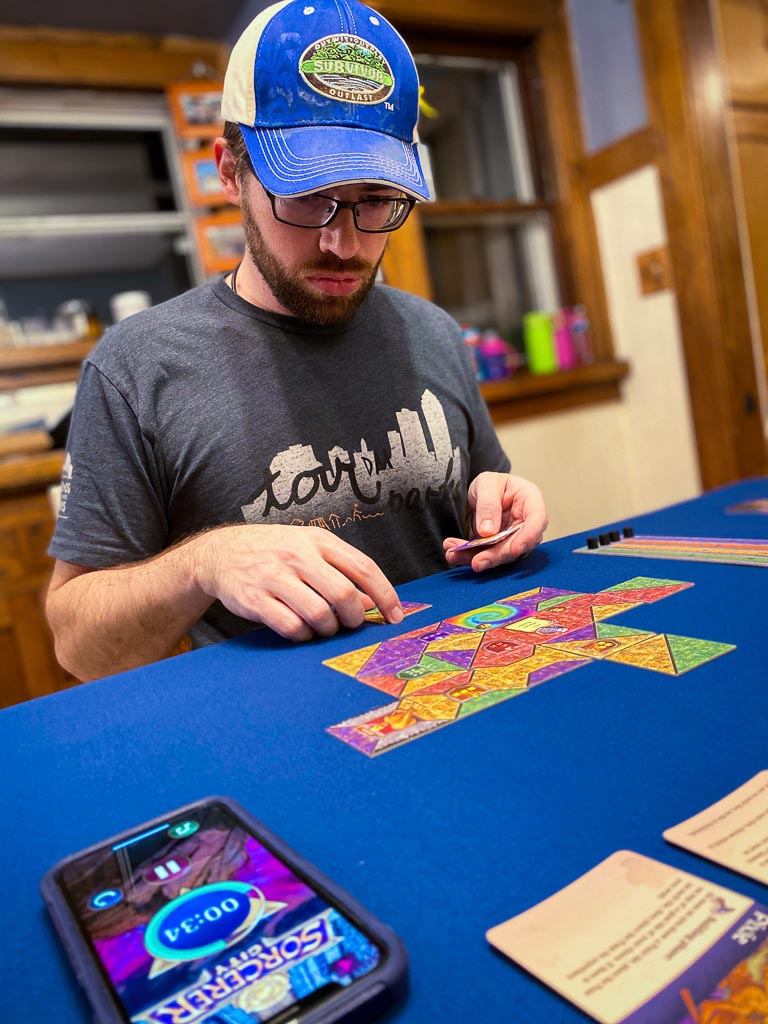
What do we think?
Sorcerer City has a lot going on that all touches on game elements that we love! Tile placement, real-time play, and deck building are all meshed together to make a really fun gaming experience.
We have really enjoyed the tense and exciting feeling of rushing to build your city. Both Adam and myself really enjoy tile games and our favorite game of all time is a deck building game so this fit right in our wheel house from game one. Each decision on where to place a tile felt important and there was a definite learning curve initially in figuring out how best to design our cities to maximize their resource potential.
Sometimes the tiles really work in your favor and you can build a fantastic city with minimal effort, other times you’ll need to take all the time you have to figure out the best way to leave space for those tiles you desperately need but have yet to draw.
Choosing what to change your raw magic into after cities have been built provides a fun and difficult decision. If you can convert it into influence and secure the big influence reward that’s great, but if someone else edges you out, you might be better off converting it into Prestige points or perhaps money in order to buy the tiles you need at the market to build a better city next round.
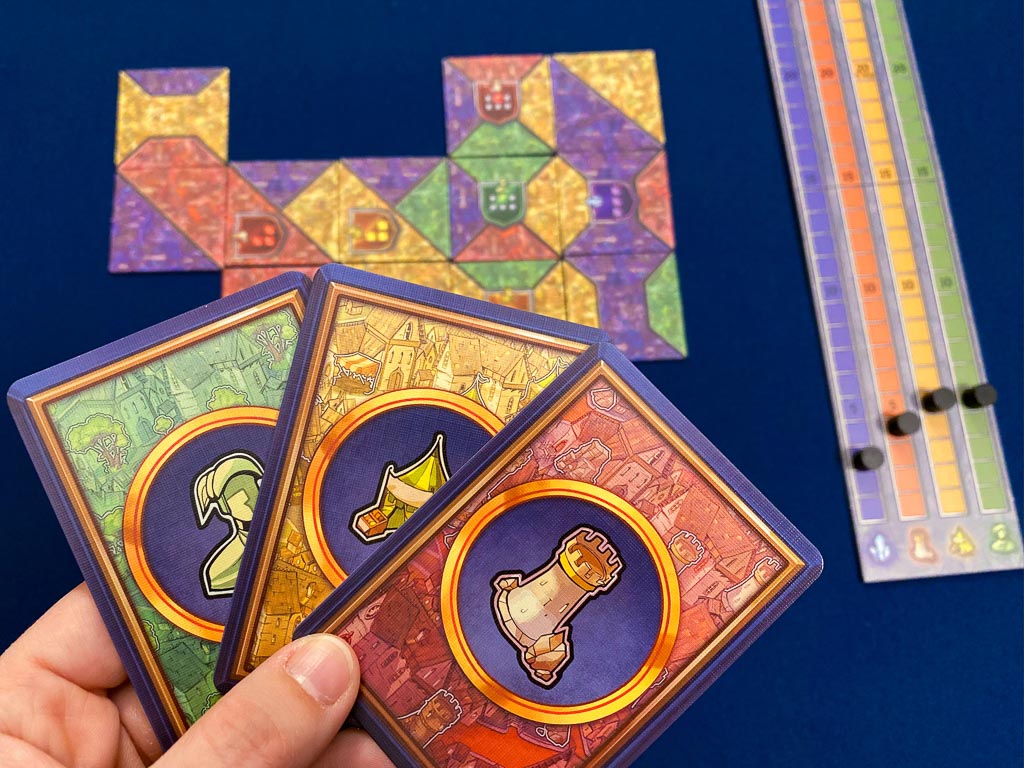

While there is definitely an element of luck, I find it to be well mitigated with the choices players have in what tiles they choose to buy and when. As always with deck building games, you’ll have to weigh the benefits of building a deck full of lots of special tiles with the reality that if you build it too thick, you’ll never get through them all to use them.
We enjoyed how the Monster tiles create a wrinkle in the city building plans you might have had. There are 14 monsters included in the game and each impacts the players in either the building or scoring phases to make building your city a bit more difficult. We like the tricky decision you had to make during the build phase about where to place them or, if you had already built a city that was looking pretty good, how you might choose to stop drawing tiles in an effort to avoid having to place a monster in your city and negatively impact your score.
After a few games though, it was fun to see how we both learned how to build our cities in such a way so that we could plan for the monster and not have to worry about them harming us too greatly.

How does it play with two?
Sorcerer City plays great with two. Because of the Influence Reward phase,you need to add in a fake player. Personally, I am not a fan of games where I need to have a third “dummy” player that we have to control and worry about. Thankfully that is not the case here and what you do is really simple. You simply flip over cards for the third player to randomly be given an Influence Score as if they had built a city. So you’ll have to make sure you beat their score as well if you hope to claim the main Influence Reward.
Theme
Overall, I don’t find the theme to be that important. That’s not to say anything negative about the game in this regard, it’s just that the theme doesn’t matter. It literally could have been anything or nothing and worked just as well. So If you’re buying it because you are really enticed by the theme, just be aware that it doesn’t play a role much at all.
Components
I think the components are relatively good. I would have liked to perhaps seen slightly thicker tiles, but if you tend towards purchasing a lot of tiles during the buy phase your stack of city tiles might become too difficult to handle.
The organizer that comes with the box is absolutely fantastic and truly essential. This will help players get the game to the table far more often. I love how smooth the set up and tear down is with the insert. Truly first rate.
The game does come with a sand timer, but we suggest downloading the free timer app off of the App Store if able. This not only allows players to fully focus on building their cities without needing to keep an eye on the sand timer, but also gives the ability to add a soundtrack to the game which amps up the tension and makes the building phase even more exciting.

Can kids play?
While the box says 14+, I’d say that you should be able to play this with a 10 year old no problem. There’s a lot to remember at first, but after a few plays they should have no issues. Any younger and I’d think the game might be beyond them.
Drawbacks
While there are a lot of things to enjoy about Sorcerer City, we did find a few drawbacks to the game that we feel are worth mentioning.
Highly Favors Experienced Players
When it comes to winning, Sorcerer City highly favors players who have played a few games before. While this could be said of many games, the likelihood of “beginner’s luck” with this one is pretty low in our experience. There is a definite learning curve to knowing how to best design and build your city in the two short minutes allotted to maximize your resources. Players who know how to do this from the start are going to get a huge jump on players that are still figuring it out.
Monster Tiles Can be Difficult to Remember
One thing I wish they would have done was to incorporate some type of easily interpreted iconography to the monster tiles. As it is, you just have to remember what each of them do and when you’re trying to speed build your city, it’s pretty tough.
In nearly every game I, Adam, or someone else has had to spend valuable build time looking up or explaining again what a monster can do. It would have been much nicer if the monsters would have had something on them to indicate the effect they take when drawn.
Could you commit their powers to memory? Sure, but your initial plays are going to be hurt by it and it’s during arguably the most crucial part of the game. This will most assuredly benefit players who have played before over those that are playing it for the first time.
You’re Going to Need a Bigger Table
This game is a table hog. We even have a 7 foot table and our four player game was pushing it. Each player is able to build their city however they want, so sometimes we ended up holding tiles off the table or running into each other in the middle. This wasn’t so much of an issue in our 2 player game, but there’s still a decent amount of space you need to plan for. If you have a smaller table, you’ll be better off playing this one on the floor.

Replayability
I worry about the replayability of Sorcerer City. While it’s true that there are a lot of market tiles that you can purchase and that due to the variability of what you purchase and what you draw to place in your city during the build phase will technically make every game different I’m not sure if this is one that will have enough here to make it a permanent addition to our shelf.
I truly enjoy playing Sorcerer City, yet, after multiple plays kind of have the feeling that I’ve seen all that it has to offer. At this moment, I don’t really see any large depth to strategy or unique ways to win that would fuel me to continue coming back to this game again and again.
That’s not to say that it isn’t fun, it is! I just don’t get a sense of the staying power that I do from other games.
Summary
All in all, Sorcerer City is a really fun game that combines a lot of different mechanics to make a nice, smooth game that all plays out satisfactorily in about 45 minutes. While players with a few games under their belt will have a significant advantage over new players, Sorcerer City is very easy to teach and is sure to delight fans of real-time elements in games as well as lovers of tile placing mechanics.
With all of the various elements involved, we recommend Sorcerer City to folks who have moderate board game experience so as not to be overwhelmed with the combination of so many various mechanics.
We greatly enjoy playing Sorcerer City and recommend that if you get the chance, you give it a try as well!
A special thank you to the folks at Skybound and Druid City Games for sending us this copy of Sorcerer City to play and review. As always, our thoughts and opinions are our own.
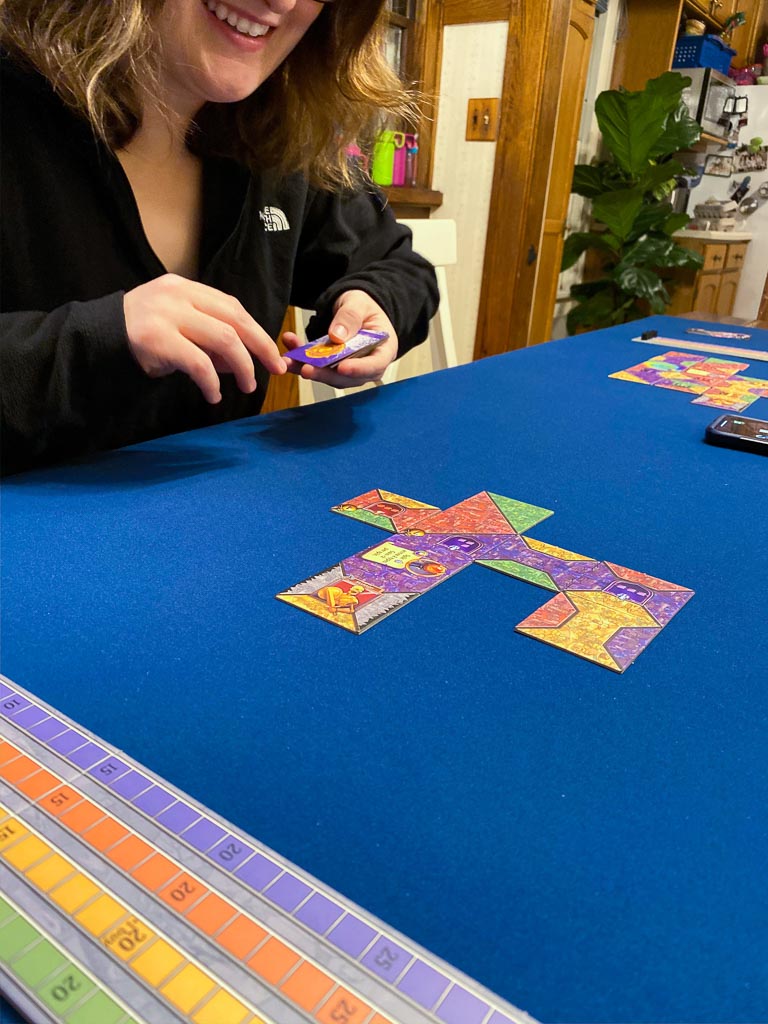
Game Info:
Title: Sorcerer City
1-6 players Ages 14+
Designer: Scott Caputo
Artists: Noah Adelman, Lina Cossette, David Kegg, Damien Mamoliti
Publisher: Druid City Games, Skybound Games
Published: 2019
If you enjoyed this post, you may also like:
Tapestry – Review
10 More Great Date Night Games
Skulk Hollow – Review


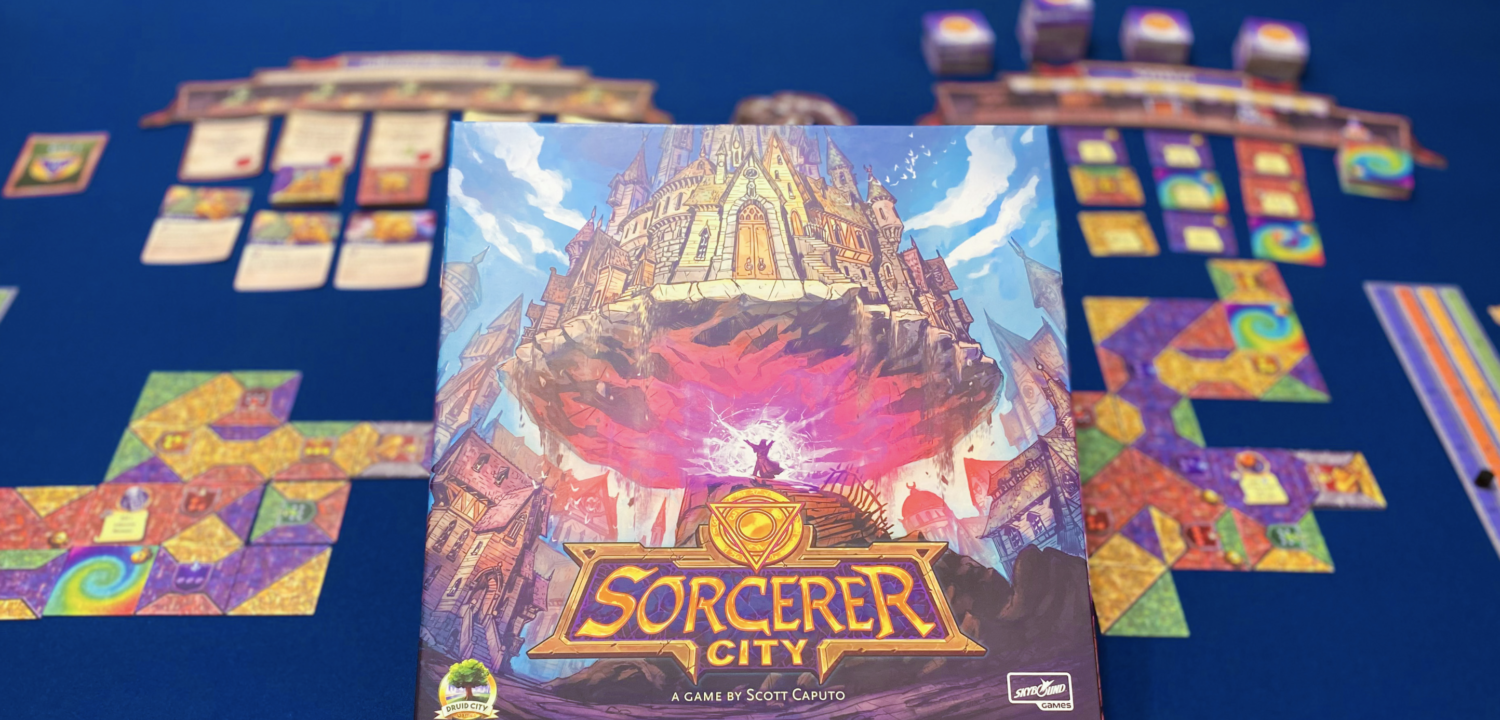


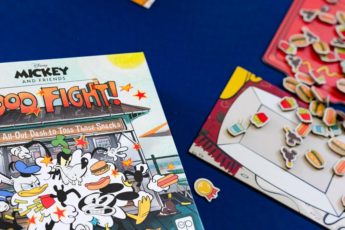






Leave a Comment